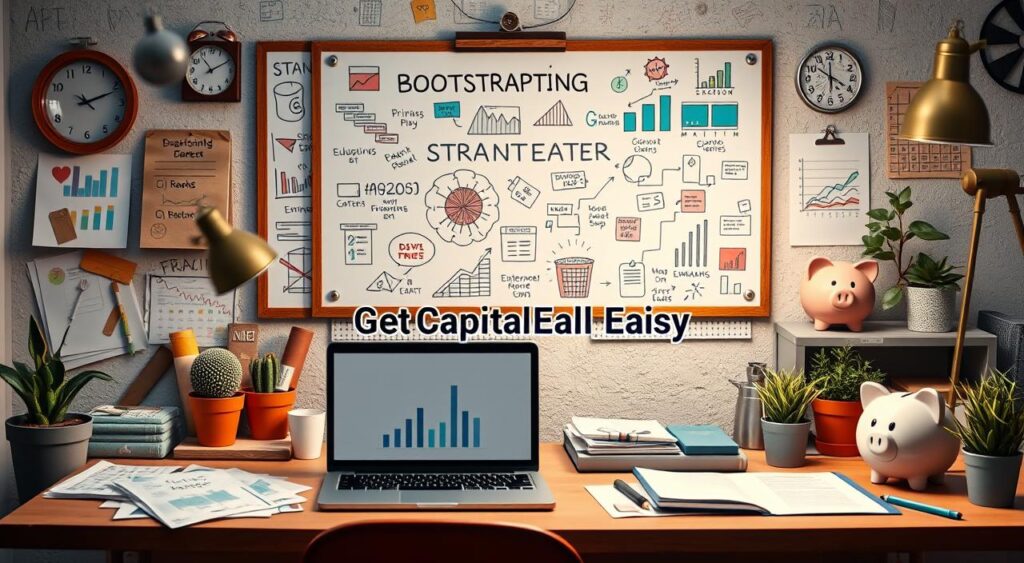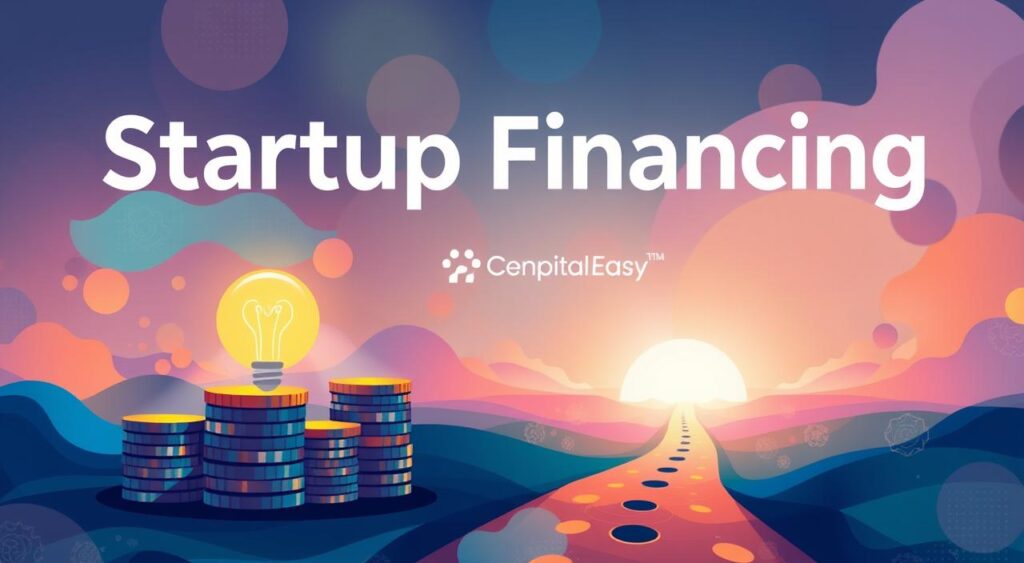Do you have a great business idea but no money to start? Don’t give up on your dream. There are startup loans available even if you don’t have any income yet.
This guide will help you find ways to fund your startup, even without income. We’ll look at non-traditional funding options and share strategies to get your business started. You’ll learn about seed funding, bootstrapping, and government grants. This will help you launch your business, even without a steady income.
Key Takeaways
- Startup business loans with no revenue can provide the necessary capital to launch and grow your business.
- Overcoming the challenges of pre-revenue funding requires a solid business plan, financial projections, and a deep understanding of alternative financing options.
- Leveraging personal savings, crowdfunding, and government grants can be effective bootstrapping strategies for pre-revenue startups.
- Attracting seed funding and early-stage investors requires a compelling pitch deck and a clear demonstration of market potential.
- Increasing your chances of approval for startup loans with no revenue involves building a strong credit profile and showcasing traction in your target market.
Understanding the Challenges of Pre-Revenue Funding
Starting a business without any income can make getting money hard. Banks and investors are cautious about lending to new companies without a history of making money. But, a strong business plan and financial forecasts can show your business’s potential. This can help you get funding even without revenue.
Why Securing Financing is Difficult for Startups with No Revenue
Lenders and investors look at a company’s past and current money-making to decide if it’s safe to invest. Without any money made, startups find it hard to show they are a good and safe bet.
The Importance of a Solid Business Plan and Projections
To get past this problem, startups need a detailed business plan. It should explain how they plan to grow, who they will sell to, and how they will make money. Showing a clear way to make money and a solid plan can help startups get loans or other funding.
| Challenges of Pre-Revenue Financing | Strategies to Overcome Them |
|---|---|
| Lack of financial history and track record | Develop a detailed business plan and financial projections |
| Perceived high risk for lenders and investors | Demonstrate market potential and growth strategy |
| Difficulty in securing collateral or guarantees | Explore alternative financing options, such as crowdfunding or government grants |
By tackling these challenges and showing why their business is worth investing in, startups without revenue can get the money they need. This can help them grow and succeed.
Exploring Non-Traditional Financing Options
Startups without revenue face a tough time getting bank loans or venture capital. They need to think outside the box for startup financing. Options like crowdfunding, personal loans, and government grants might be more within reach.
Crowdfunding is a hit among entrepreneurs. It lets them raise money from many small investors online. This way, they can get early-stage startup capital without needing to show profits yet.
Bootstrapping startup loans are another choice. Founders use their own savings, credit cards, or home equity to fund their business. It’s riskier than traditional loans, but it can help startups get started.
Startups should also look into government grants and programs. These often support new ideas, especially those that create jobs and boost the economy. They can be a big help for startups without revenue.
“The key is to be creative and tenacious when exploring non-traditional financing options. With the right mindset and a solid business plan, startups can often find the funding they need to turn their dreams into reality.”
Startup Business Loans with No Revenue: An Overview
Getting a loan for a startup with no income is tough. But, there are loans made just for pre-revenue companies. This section talks about the different startup loans, what you need to qualify, and how to apply.
Types of Startup Loans for Non-Revenue Companies
Startups without income can look into several loan options. These include:
- SBA Loans: The U.S. Small Business Administration (SBA) has programs like the SBA 7(a) loan and the SBA Microloan program for startups.
- Microloans: Nonprofits and community groups offer small, short-term loans. They help startups that banks might not.
- Alternative Lenders: Online lenders like Kabbage, OnDeck, and Fundbox are more flexible. They might lend to startups without income.
Eligibility Criteria and Requirements
Most lenders for startup business loans with no revenue or no income business loans look at a few key things. These are:
- Strong business plan and financial projections: Lenders want to see a solid business plan and financial forecasts. They check if the startup can make money in the future.
- Collateral or personal guarantees: Lenders might ask for personal guarantees or collateral. This could be personal assets to secure the loan.
- Credit history and scores: Lenders check the credit of the startup founders. They look at creditworthiness and ability to repay the loan.
- Traction and market potential: Lenders want to see the startup’s progress. This includes pre-orders, pilot programs, or partnerships. They also look at the startup’s growth potential in the market.
Knowing about non-revenue startup loans and what lenders look for helps entrepreneurs. It makes it easier to find the funding needed to start and grow a business.
Bootstrapping Strategies for Pre-Revenue Startups
For startups without revenue, self-funding or “bootstrapping” can be a good option. This section looks at using personal savings, credit, and crowdfunding to fund your venture. It shows how to do this without traditional lenders.
Leveraging Personal Savings and Credit
One common bootstrapping method is using your personal savings or taking out a loan against your home equity. This way, you keep full control over your business. But, it’s important to check your finances and not overextend yourself.
Crowdfunding and Alternative Financing Models
Crowdfunding sites like Kickstarter and Indiegogo are popular for startups. They let you raise funds from many backers in exchange for rewards or equity. Other options like crowdfunding and peer-to-peer lending also offer capital without bank loans.
Choosing a bootstrapping strategy needs a solid business plan and a clear vision. By using your personal resources and alternative financing models, you can help your startup grow.

| Bootstrapping Strategy | Advantages | Disadvantages |
| Personal Savings and Credit |
|
|
| Crowdfunding |
|
|
| Alternative Financing Models |
|
|
Attracting Seed Funding and Early-Stage Investors
Getting traditional business loans can be tough for startups without revenue. But, you can look for seed funding from early-stage investors. These investors, like angel investors or venture capitalists, might back your startup for a share of it. To get their interest, you need a strong pitch deck that shows your business’s promise.
Building a Compelling Pitch Deck
A good pitch deck is key when you’re looking for seed funding. It should clearly share your business idea, market chance, and how you stand out. It’s also important to show your team’s skills and any progress you’ve made, even without making money yet. Here are some important parts to include in your pitch deck:
- Problem and Solution: Explain the problem your business solves and how your product or service is different.
- Target Market and Traction: Show you know your market and any early interest or customers you’ve gotten.
- Competitive Landscape: Name your competitors and explain how your product stands out.
- Business Model and Financials: Share how you plan to make money and your financial plans, even without current income.
- Team and Expertise: Emphasize your team’s experience and skills to build investor trust.
- Capital Requirements and Use of Funds: Say how much seed funding you need and how you’ll use it to grow your early-stage startup.
By making a strong pitch deck that covers these points, you’ll have a better chance to draw in seed funding and early-stage startup capital investors. They can give your business the money it needs to grow.
Government Grants and Programs for Startups
Getting startup financing can be tough, especially for businesses without income. But, governments at all levels have grant programs to help. These programs support entrepreneurship and small business growth. They are great for startups looking to start their journey.
The Small Business Innovation Research (SBIR) and Small Business Technology Transfer (STTR) programs are well-known. They offer grants for research and development, focusing on new technologies. Startups that qualify can get these grants, helping them grow financially.
There are many other government grants for startups too. These include support for women-owned, minority-owned, and specific industry businesses. State and local governments also have their own grants and tax breaks to help new businesses.
| Program | Description | Eligibility |
|---|---|---|
| Small Business Innovation Research (SBIR) | Provides funding for research and development of innovative technologies | Small businesses with fewer than 500 employees |
| Small Business Technology Transfer (STTR) | Supports the commercialization of technologies developed through university research collaborations | Small businesses with fewer than 500 employees that partner with a research institution |
| State and Local Grant Programs | Numerous state and local governments offer their own grant programs and incentives to support startups and small businesses | Eligibility criteria vary by location and program |
To use these government grants, startups need to be proactive. They must research and apply for the right programs. A good business plan, financial projections, and a strong pitch are key. With effort and the right strategy, startups can get the funding they need to succeed.

Startup Business Loans with No Revenue: Pros and Cons
Getting startup business loans without any revenue is tough but can be rewarding. The risks are higher, but the benefits can be great for those who are ready to face the challenges. Let’s look at the good and bad sides of getting startup business loans with no revenue, no income business loans, and non-revenue startup loans.
Pros of Startup Business Loans with No Revenue
- Access to capital: Non-revenue startup loans can give you the money you need to start and grow your business. Even when regular lenders say no.
- Flexibility: These loans often have more flexible payment plans. This lets you focus on your business without worrying about strict loan rules.
- Validation and credibility: Getting a startup business loan with no revenue shows that your business idea is good. It tells investors and customers that they should support you.
Cons of Startup Business Loans with No Revenue
- Higher risk: Lenders see no income business loans as riskier. This can mean higher interest rates, stricter rules, or even no loan at all.
- Collateral requirements: You might have to use personal things or guarantees to get these loans. This can risk your personal money.
- Limited options: There are fewer lenders for startup business loans with no revenue. This means you have less power to negotiate and fewer choices.
Deciding to get startup business loans with no revenue needs careful thought. You should think about the risks and benefits, and have a solid business plan. This can help you get the funding you need to make your business dream come true.
| Pros | Cons |
|---|---|
| Access to capital | Higher risk |
| Flexibility | Collateral requirements |
| Validation and credibility | Limited options |
Tips for Increasing Your Chances of Approval
Getting startup business loans with no revenue can be tough. But, there are ways to boost your chances. Startups can show they’re worth the investment by improving their credit and proving they have a good market plan.
Building a Strong Credit Profile
Lenders check the credit history of the business owner for no income business loans. To improve your score, pay bills on time and lower your debt. Fixing any credit report mistakes also helps. A good credit score is key for getting non-revenue startup loans.
Demonstrating Traction and Market Potential
Startups without revenue can still show they’re on the right track. This means sharing customer growth, demand, or partnerships. A detailed business plan that shows how you’ll grow can help get funding.
By focusing on these areas, entrepreneurs can better their chances of getting the startup business loans with no revenue they need. This can help take their business to new heights.
Case Studies: Successful Startups Funded Without Revenue
Securing startup financing can be tough for businesses without revenue. Yet, some startups have found ways to get funded. Let’s look at a few inspiring stories of how they did it.
Airbnb is a great example. When it started, it had no revenue. But founders Brian Chesky and Joe Gebbia got $20,000 from Y Combinator. They used this money to build a strong pitch and then raised $600,000 from Sequoia Capital. Airbnb shows that a good plan and a unique idea can attract investors, even without revenue.
Stripe is another success story. Despite no revenue, it got $2 million from Sequoia Capital and Peter Thiel. Stripe’s new way of handling payments caught investors’ attention. This helped it get the pre-revenue business financing it needed.
These stories show that startups with no revenue can still get funded. By focusing on their market potential and disruption, entrepreneurs can overcome financing hurdles. This way, they can turn their ideas into successful businesses.
Conclusion
Starting a business can be tough, especially when you don’t have any income yet. This article has shown you many ways to get funding for your startup. By looking into different loans and financing options, you can get the money you need to start your business.
Looking for seed funding or government grants? The key is to have a solid business plan and a great pitch. Show that your startup has potential and you’re ready to grow. This way, you can get the loans or funding you need to grow your business.
Starting a business comes with challenges, but you can overcome them. Use the tips from this article to get the funding you need. Take the first step towards making your business dream a reality.
FAQ
What are the main challenges of securing startup business loans with no revenue?
Startups without income face big hurdles in getting loans. Lenders and investors are cautious without a proven income. Without collateral or credit history, it’s tough for these startups to get the funding they need.
How can a solid business plan and financial projections help in securing pre-revenue funding?
A good business plan and financial projections show a startup’s potential. They help lenders and investors see the business’s future. This increases the chance of getting the funding needed.
What are some non-traditional financing options available for startups with no revenue?
For startups without income, there are other funding options. Crowdfunding, personal loans, and government grants are available. These options might be easier to get than traditional bank loans.
What types of startup loans are available for non-revenue companies?
There are loans made just for startups without income. SBA loans, microloans, and loans from alternative lenders are some. Each has its own rules, so it’s important to find the right one.
How can bootstrapping strategies help pre-revenue startups get funded?
Bootstrapping is a way for startups without income to fund themselves. Using personal savings, credit, or crowdfunding can help start a business without traditional loans.
What are the key elements of a compelling pitch deck for attracting seed funding and early-stage investors?
Startups need a strong pitch deck for seed funding. It should explain the business model, market, and growth plans. A good pitch deck can help entrepreneurs get the funding they need.
What government grants and programs are available for startups with no revenue?
Government grants and programs support startups. They offer funding for entrepreneurship and small business growth. These opportunities can help startups without income get started.
What are the potential pros and cons of pursuing startup business loans with no revenue?
Getting loans without income has both good and bad sides. The pros include getting capital and building credit. But, there are also higher interest rates and strict rules. Entrepreneurs should think carefully before choosing this path.
How can startups increase their chances of approval for startup loans with no revenue?
To get loans without income, startups can improve their chances. Building a strong credit score and showing market potential helps. Highlighting experience and the management team also matters.
Can you provide examples of successful startups that were able to secure funding without revenue?
Yes, many startups have gotten funding without income. Their stories can inspire and guide others. By learning from their success, aspiring entrepreneurs can find their own way to fund their startups.

